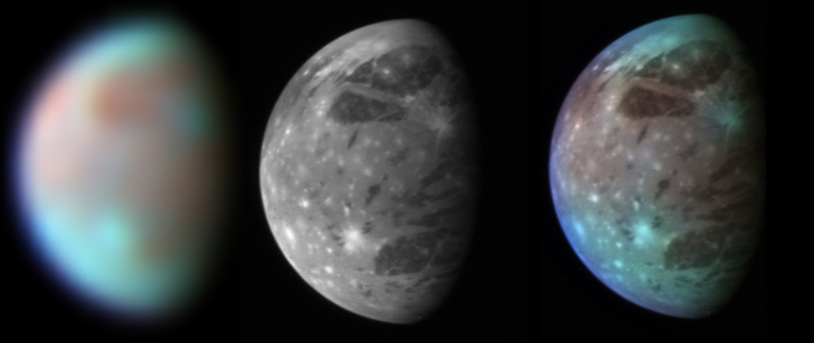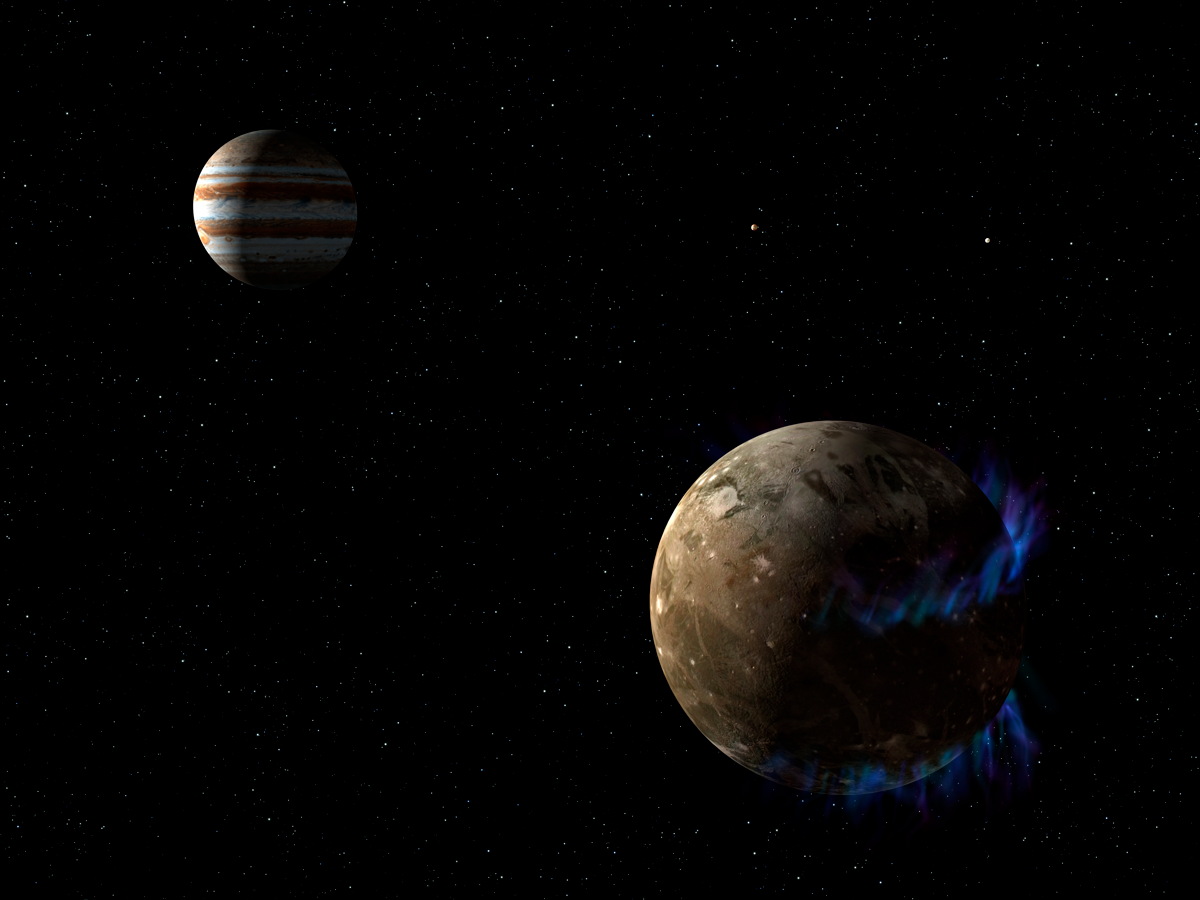Ganymede: A guide to the largest moon in the solar system

Ganymede is Jupiter's largest moon and is also the largest moon in the entire solar system.
It is bigger than both Mercury and dwarf planet Pluto and only slightly smaller than Mars. The moon likely has a salty ocean underneath its icy surface, making it a potential location for life.
Ganymede is the primary target for the European Space Agency's (ESA's) Jupiter icy moon explorer mission (JUICE) that launched on April 14, 2023, at 8:14 a.m. EDT (1214 GMT) and is expected to arrive in the Jovian neighborhood in December 2031.
Related: The 10 weirdest moons in the solar system
Facts about Ganymede
How old is Ganymede?
Ganymede is about 4.5 billion years old, about the same age as Jupiter.
How far is Ganymede from Jupiter?
Ganymede is the seventh moon and third Galilean satellite outward from Jupiter, orbiting at about 665,000 miles (1,070 million kilometers). It takes Ganymede about seven Earth days to orbit Jupiter.
How big is Ganymede?
Ganymede's mean radius is 1,635 miles (2,631.2 km). Although Ganymede is larger than Mercury it only has half its mass, classifying it as low density.
What's the temperature on Ganymede?
Daytime temperatures on the surface average ranging from minus 171 degrees Fahrenheit to minus 297 F, according to NASA.
Does Ganymede have a magnetosphere?
Ganymede is the only satellite in the solar system to have a magnetosphere. Typically found in planets, including Earth and Jupiter, a magnetosphere is a comet-shaped region in which charged particles are trapped or deflected. Ganymede's magnetosphere is entirely embedded within the magnetosphere of Jupiter, according to NASA.
When was Ganymede discovered?
Ganymede was discovered by Galileo Galilei on Jan. 7, 1610. The discovery, along with three other Jovian moons, was the first time a moon was discovered orbiting a planet other than Earth. Galileo's discovery eventually led to the understanding that planets orbit the sun, instead of our solar system revolving around Earth.
Galileo called this moon Jupiter III. When the numerical naming system was abandoned in the mid-1800s, the moon was named after Ganymede, a Trojan prince in Greek mythology. Zeus, a counterpart of Jupiter in Roman mythology, carried Ganymede, who had taken the form of an eagle, to Olympus, where he became a cupbearer to the Olympian gods and one of Zeus' lovers.
How many spacecraft have visited Ganymede?
Several spacecraft have flown by Jupiter and its moons. Pioneer 10 arrived first, in 1973, followed by Pioneer 11 in 1974. Voyager 1 and Voyager 2 returned striking photos during their flybys. The Galileo spacecraft passed as low as 162 miles (261 km) over the surfaces of the Galilean moons and produced detailed images.
Breaking space news, the latest updates on rocket launches, skywatching events and more!
ESA's JUICE mission will look at three moons (Ganymede, Callisto and Europa), Ganymede will be the focus because it shows how icy worlds evolve and could be habitable in general. Scientists will try to figure out more about its ocean and icy crust, map its surface in detail, learn about the interior, probe the atmosphere and study the magnetic field.
Ganymede surface characteristics
Ganymede has a core of metallic iron, which is followed by a layer of rock that is topped off by a crust of mostly ice that is very thick. There are also a number of bumps on Ganymede's surface, which may be rock formations.
In February 2014, NASA and the United States Geological Survey unveiled the first detailed map of Ganymede in images and a video animation created using observations from NASA's Voyager 1 and Voyager 2 spacecraft, as well as the dedicated Jupiter-orbiting Galileo spacecraft.
Ganymede's surface is made up of primarily two types of terrain: about 40 percent is dark with numerous craters, and 60 percent is lighter in color with grooves that form intricate patterns to give the satellite its distinctive appearance. The grooves, which were likely formed as a result of tectonic activity or water being released from beneath the surface, are as high as 2,000 ft (610 meters) and stretch for thousands of miles.
It is believed that Ganymede has a saltwater ocean below its surface. In 2015, a study by the Hubble Space Telescope looked at Ganymede's auroras and how they change between Ganymede's and Jupiter's magnetic fields. The "rocking" seen by the auroras gives evidence that the probable ocean underneath is salty, more salty than oceans of Earth, scientists said at the time.
Some scientists are skeptical that Ganymede could host life, however. Due to its internal structure, it is believed that the pressure at the base of the ocean is so high that any water down there would turn to ice. This would make it difficult for any hot-water vents to bring nutrients into the ocean, which is one scenario under which scientists believe extraterrestrial life would occur.
Ganymede FAQs answered by an expert
We asked Lorenz Roth, a planetary astronomer at KTH Royal Institute of Technology, Sweden, who specializes in the study of solar system moons including the large moons of Jupiter, also known as the Galilean moons, some questions about Ganymede.
Lorenz Roth is a planetary astronomer at KTH Royal Institute of Technology, Sweden, who specializes in the study of solar system moons.
Why is Ganymede fascinating to scientists?
Ganymede is larger than Europa, the largest of all moons we have in the solar system. And it is the only moon that produces its own magnetic field in the interior. Only planets and suns or stars have magnetic fields — and Ganymede. A certain size is likely a required characteristic for the conditions in the interior that allow the processes generating the magnetic field.
Is Ganymede bigger than Earth?
Ganymede's radius is 2.5 times smaller than the Earth's at [1,640 miles] 2,640 kilometers. It is larger than Mercury.
Does Ganymede have an atmosphere?
It has a very dilute gas envelope that is constantly lost or destroyed and produced again from the surface. The gas density is so low that the molecules almost never collide with one another.
What is Ganymede made of?
Ganymede consists primarily of silicate rock with an ice shell outside. The ice shell is thicker than Europa's.
What would happen if Ganymede were our moon?
That is an interesting question. A key parameter to know would be how far it would be from the Earth. Let's assume it would be at the same distance as our moon. Then it would appear much brighter and also bigger in the sky. Ganymede reflects light almost four times better and the area of its disk is two times larger. So we would have day-like brightness on a full moon night. And its mass is also two times larger than that of our moon — the ocean tides created would also be twice as large!
Additional resources
Explore Ganymede in even more detail with these resources from ESA and find out why it was chosen as the primary target for the JUICE mission. Explore 10 interesting facts about Ganymede in this article published on Astronomy Trek.
- Daisy DobrijevicReference Editor



